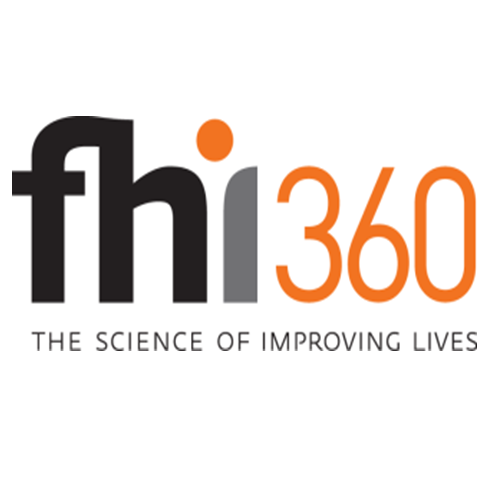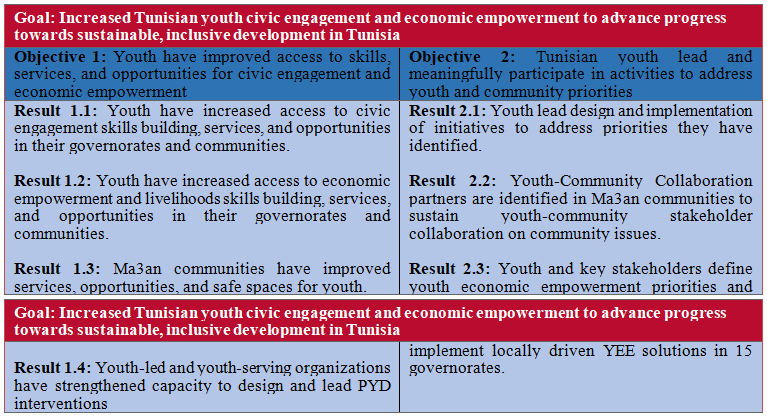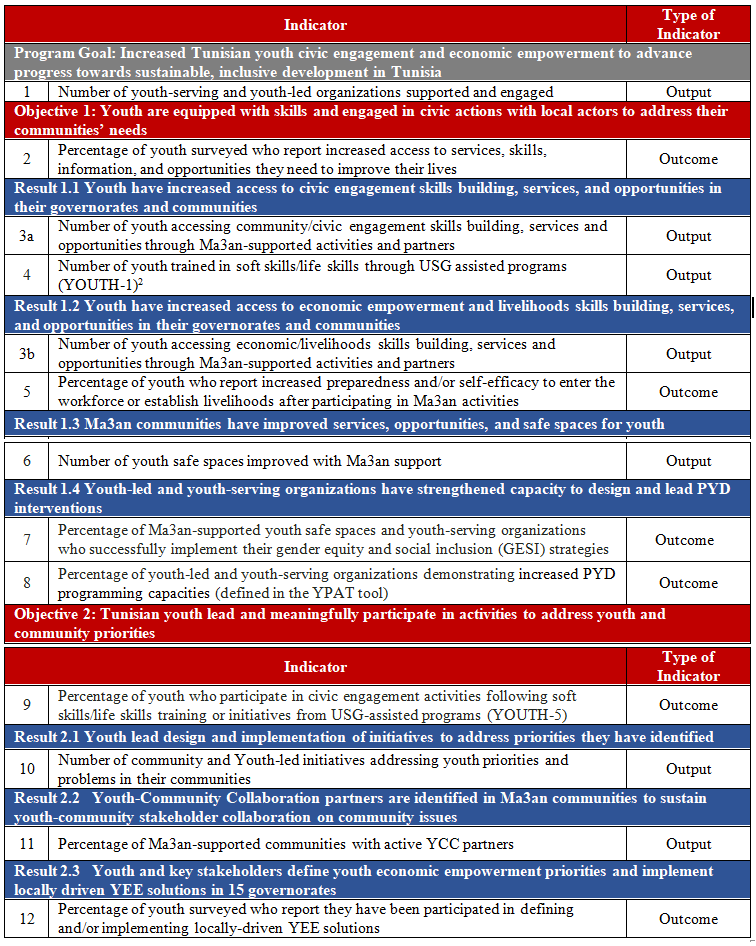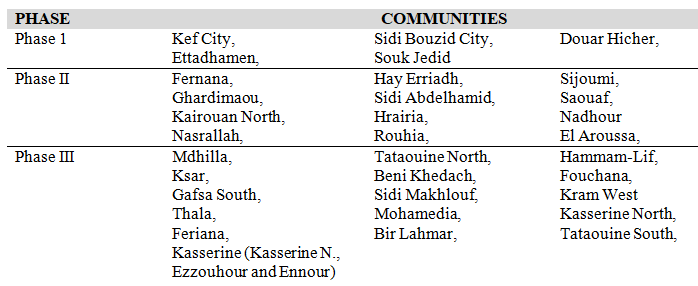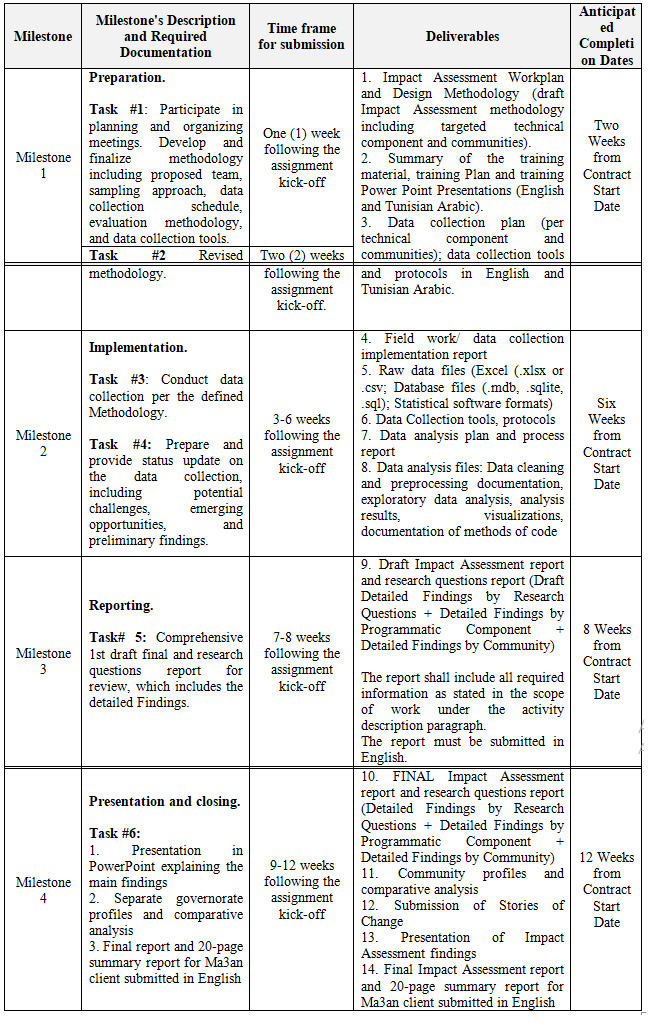Appel d’offres pour les sociétés – FHI360 عودة إلى الفرص
FHI 360
يطلق Appel d’offresانتهاء الصلاحية
30 أوت 2023 Il y a 2 ans
شارك الفرصة على
تفاصيل الفرصة
Request for Proposals
Ma3an Impact Assessment
Solicitation Number: MA3AN/FHI360/RFP/2023/002
- To: Qualified and Eligible Companies Specialized in Monitoring and Evaluation Services with Emphasis in Positive Youth Development (PYD) Impact Assessments.
- From: Patrick O’Mahony, Chief of Party, Ma3an Project
- Contract Title: Ma3an Impact Assessment
- Date Issued: August 14, 2023
- Questions Concerning the RFP: August 22, 2023
- Submission Deadline: August 30, 2023
BACKGROUND
The United States Agency for International Development (USAID) is funding the Ma3an project, a seven-year (September 2018 – August 2025) project that aims to increase Tunisian youth civic engagement and economic empowerment to advance progress towards sustainable, inclusive development in Tunisia.
Ma3an is implemented by FHI 360, a non-profit human development organization dedicated to improving lives in lasting ways by advancing integrated, locally driven solutions. Ma3an works in 33 communities in 15 governorates across Tunisia included in Graph 1 below.
Graph 1. Ma3an Target governorates and communities
Ma3an Objectives and Theory of Change:
Ma3an’s goal, objectives, Theory of Change, and Results Framework are as follows:
The program’s revised goal is Increased Tunisian youth civic engagement and economic empowerment to advance progress towards sustainable, inclusive development in Tunisia. Ma3an’s goal is achieved through two inter-related and overlapping objectives:
- Objective 1: Youth have improved access to skills, services, and opportunities for civic engagement and economic empowerment.
- Objective 2: Tunisian youth lead and meaningfully participate in activities to address youth and community priorities.
To achieve these objectives, Ma3an builds upon the strengthened local capacities, youth safe spaces, youth skills-building and empowerment, and increased youth-community engagement and collaboration resulting from the Ma3an community resilience process and other youth engagement activities implemented in 33 marginalized communities. Ma3an activities are guided by the principles of Positive Youth Development (PYD), with further resources committed to improving youth access to skills, services, and opportunities, and increasing opportunities for youth to lead, and meaningfully participate in, addressing youth and community priorities. Ma3an provides these communities, including youth, civil society, government, and private sector stakeholders, with the tools and resources necessary to operationalize sustainable development.
Theory of Change: IF youth access skills, services, and opportunities for civic engagement and economic empowerment, and IF youth lead and meaningfully participate in, addressing youth and community priorities, THEN Tunisian youth will be more civically engaged and economically empowered and thus better able to drive progress towards sustainable, inclusive development.
Ma3an’s Results Framework:
SCOPE OF WORK
FHI 360 is launching a competitive tender to award a fixed priced contract to eligible contractors or firms with the capacity to formulate, manage, implement, and deliver an Impact Assessment to rigorously measure and assess the impact of the project interventions through a mixed methods approach, with a quantitative component using a quasi-experimental design and a qualitative, participatory component.
All offerors are required to submit their proposals in English. Proposals submitted in any other language may be disqualified from consideration.
2.1 Assessment Objective
The purpose of this RFP is to solicit applications to conduct an Impact Assessment for the Ma3an Project. To complement traditional quantitative performance indicators, Ma3an seeks to employ an assessment to comprehensively assess the impact and effectiveness of the Ma3an project, which includes looking back and following up with individuals reached at the start of the project to track progress and outcomes over subsequent years. There are limitations to this approach (see section 2.4), and the impacts we will explore are from the perspective of these individuals only. The retrospective assessment aims to provide insights into the project’s progress and outcomes, inform decision-making, and identify areas for improvement.
Overall, the aim of this Impact Assessment is to ascertain whether and to what extent there is a change in the practices of Ma3an’s youth and partner Civil Society Organizations (CSOs). Specifically, this assessment aims to showcase how the youth have become more engaged in community activities and how they have applied the skills acquired through Ma3an’s trainings in their lives beyond the program. Providing specific examples to illustrate the impact on both youth and CSO trainings.
Ma3an aims to assess program participant perceptions of outcomes resulting from the support provided by Ma3an to individuals, local partners, CSO and stakeholders reached in Year 1 to Year 5. Additional, external factors may influence these outcomes, which we will seek to capture along with both intended and unintended effects, whether positive or negative.
The selected offeror will be responsible for all aspects of this study, including the methodological design; data collection processes; analysis; and dissemination of findings (including a final report and presentation to the program and USAID). FHI 360 expects that the assessment will result in documenting the main changes that have happened because of the program, as well as its intended and unintended consequences. These findings will then be used to inform improvements to Ma3an (or future iterations of the program), contribute to lessons learned and identify necessary implementation adaptations.
2.2 Research Questions
The offeror will utilize the PYD[1] model as the analytical framework for the assessment. The PYD model aligns with Ma3an’s integrated approach in empowering youth to address their needs and contribute to their communities, ultimately fostering sustainable and inclusive development in Tunisia.
The assessment includes several illustrative research questions. A “Pause & Reflect” session will take place in the first week of October, leading to the finalization of the questions. In this submission, the offeror may also propose additional research questions they find relevant.
Illustrative Research Questions:
- DOMAIN: Contribution
- Program Feature: Youth Engagement and Contribution
Research Question/s:
- Have there been positive changes in the community following the implementation of Ma3an initiatives? To what extent did Ma3an’s initiatives contribute to any cited/observed changes? Provide specific examples.
- In what ways has Ma3an contributed to the enhancement of youth civic engagement, leadership, and self-efficacy? Please specify the interventions and provide tangible examples to illustrate the project’s contributions to youth leadership, engagement, and advocacy in the civic space.
- How many youth-led initiatives were implemented with Ma3an direct support? How many youth-led initiatives were implemented by Ma3an youth without direct support from the project? What outcomes have been achieved in both cases to date? What are the youth-led initiatives that have emerged within safe spaces, and what is their impact on youth in the targeted communities?
Program Feature: Ma3an’s Local partner and stakeholder engagement in promoting positive youth development (adapted)
Research Question/s:
- Do Ma3an’s Local partners and stakeholders continue to contribute to positive youth development (PYD-informed approaches) in their respective communities after Ma3an funding has ended? If so, provide specific examples. If not, why is this the case? How do the associations supported by Ma3an maintain engagement among Ma3an youth?
DOMAIN: Enabling Environment
Program Feature: Belonging and Membership
Research Question/s:
- How did Ma3an facilitate the increased inclusion of youth within their communities, including marginalized and at-risk individuals, youth with disabilities and female youth, and promote a sense of belonging among youth irrespective of gender, ethnicity, sexual orientation, disabilities, or other factors? Which activities were successful in increasing contributions and improving safe spaces for these groups? Provide specific examples, including those that illustrate the impacts on individual youth or communities.
Program Feature: Safe spaces
Research Question/s:
- What are the most important ways Ma3an enhanced the quality and effectiveness of youth safe spaces? Through what mechanisms has Ma3an facilitated increased collaboration and interaction among youth in safe spaces? Provide specific examples.
Program Feature: Healthy relationships and bonding
Research Question/s:
- How has the project supported the development of healthy relationships and bonding between youth and adults, including mentors, coaches, teachers, and community leaders?
Program Feature: Positive norms, expectations, and perceptions
Research Question/s:
- How has the accessibility and use of primary information dissemination channels influenced youth’s perceptions and attitudes? To what extent have the challenges and strategies associated with promoting positive messages on social media successfully counteracted prevalent negativity among youth?
Program Feature: Ma3an’s Participatory Decision-making and Community-driven Approaches (adapted)
Research Question/s:
- How have youth and community stakeholders collaborated to determine community priorities and/or make joint decisions? Provide specific examples. What observable results have come from this collaboration?
These research questions serve as a framework for gathering inputs from multiple sources. This approach ensures a holistic assessment that incorporates diverse perspectives and expertise. The offeror must explain in the proposal which questions will be addressed through quantitative data, which through qualitative data and which through a triangulation of both types of data.
Ma3an has developed an Activity Monitoring, Evaluation, and Learning Plan (AMEL Plan) with a set of Key Performance Indicators for the project’s Monitoring, Evaluation and Learning (MEL) system which explains expected outputs, outcomes, and impacts. Key Performance Indicators should be considered by the offeror when developing the proposal, particularly as the outcome indicators (see table below) will be closely linked to the project’s capacity to deliver its intended impact. While some of the indicators for the project’s success can only be measured through an ‘end of project evaluation’, intermediate indicators shall be considered:
2.3 Approach and Methodology
As a minimum requirement, the primary objective of this assessment, in alignment with USAID’s goals, is to demonstrate the extent of change in the practices of Ma3an’s youth and partner CSOs and, where possible, how these changes in practices have affected the communities. Specifically, this assessment aims to showcase if and how the youth have become more engaged in community activities, how they have applied the skills acquired through Ma3an’s trainings in their lives beyond the program and how that has affected communities.
The assessment should use quantitative (e.g., surveys) and qualitative data collection methods such as participatory research or semi-structured interviews (for example with focus groups, key informant, individual interviews, etc.) as necessary.
The assessment reach should encompass all 33 Ma3an communities spread across 15 governorates. To ensure a thorough examination, the assessment will address various programmatic components, as depicted in the following tables. FHI 360 will work with the selected offeror to finalize which partners and communities to include for each programmatic component in the Impact Assessment. The list of anticipated local implementing partners, as well as their beneficiary data will be provided once the offeror has been selected.
2.3.1 Methodological Considerations
Geography of Impact Assessment: The Impact Assessment will be implemented for the programmatic component of the project in 33 communities. Ma3an Impact Assessment aims to reach 33 communities across 15 governorates. As such, the offeror needs to understand the project implementation in these locations and propose the quantitative methodology and sample size in accordance with these localities.
Sample size: Sample sizes for each programmatic component should have a power of 80% with significance levels of .05. The sample should be representative by gender, age, and rural and urban areas. The offeror should recommend, with a clear justification, coherent sample sizes in their proposal to FHI 360.
Data collection: In collaboration with FHI 360, the offeror will develop data collection instruments and will choose the most appropriate data collection strategy. Where relevant (i.e., more efficient, and effective), the offeror should propose ICT-based data collection solutions (e.g., SMS or online survey, automated voice data collection services) for specific surveys and/or indicators.
Online Survey: To ensure a comprehensive data gathering process, the offeror, in collaboration with FHI 360, will administer an online survey targeting a larger number of youth and local stakeholders. This collaborative approach will receive support from the Ma3an MEL team and technical advisors from FHI 360’s headquarters. The offeror will have the opportunity to utilize Ma3an’s internal technical expertise, including the option to upload the data collection tool using Kobo Toolbox through FHI 360’s account. Preliminary analysis calculations indicate a minimum sample size of 825 participating youth (with at least 25 respondents per community in the 33 communities), as well as 45 representatives from CSOs and 47 representatives from youth centers, cultural centers, and municipalities. However, the offeror may propose an alternative sample size in their proposal to FHI 360, provided that it is accompanied by a clear justification.
The online survey should focus on capturing the perceptions of youth, CSOs, and a wide range of local and regional government representatives regarding Ma3an’s impact on positive youth development. It will seek to gather insights from respondents who have participated in Ma3an’s skill-building activities or initiatives, which may have been facilitated through various channels such as Ma3an CSOs, Annual Program Statement (APS) National, APS Community, Solutions to VE Dialogue (SOLVE Dialogue), Youth community serving program, Youth Mentor activities, and other relevant initiatives offered by Ma3an. The online survey will provide a comprehensive understanding of stakeholders’ perspectives on Ma3an and its influence on youth development.
Data Collection Tools Language Requirement: Selected offeror will be required to submit their data collection tools in both English and Tunisian Arabic. The tools should provide support for data collection, documentation, and user interfaces in both languages. Offerors must ensure that their tools are capable of capturing data in both English and Tunisian Arabic languages seamlessly.
Addressing the Challenge of Missing Baseline Data and No Counterfactual: Navigating an Impact Assessment without baseline data or a counterfactual to compare participants to poses a significant challenge for evaluating the effectiveness and impact of interventions. In cases where baseline data or a counterfactual are not available, innovative approaches are required to ensure a comprehensive analysis.
Therefore, the offeror is expected to propose alternative options to enhance the analysis. These options may include utilizing historical data from a similar population or setting that predates the intervention period, although it may not be ideal, it can provide some context for making comparisons. Another option is to tentatively address the counterfactual by identifying a control or comparison group comprised of people with the same characteristics as those who received Ma3an support but who did not receive the intervention, allowing for an assessment of the impact to some extent by comparing observed markers/outcomes between the intervention and control groups. Additionally, qualitative approaches such as interviews, focus groups, or case studies can provide valuable insights into the perceived impact of the intervention, compensating for the lack of baseline data and true counterfactual tracked over time since the start of project interventions.
Qualitative Approaches
Qualitative approaches should be used to respond to research questions, either by generating qualitative data to be analyzed on its own, or through triangulation and reinforcement of the quantitative data. The proposal should explain what type of qualitative data sources will be used and for what purposes the evaluator intends to use qualitative data. It is important that the qualitative data explores important information about whether and to what extent there is a change in the practices of Ma3an’s youth and partner CSOs, and where possible, how those changes have affected the communities more broadly. Specifically, this assessment aims to showcase how the youth have become more engaged in community activities and how they have applied the skills acquired through Ma3an’s trainings in their lives beyond the program.
The offeror will propose a qualitative (ideally participatory) methodology to engage with young people being evaluated. The offeror will explain why this methodology will be used, including details about the types of qualitative evaluation tools to be used on different types of respondents and why (e.g., Focus Groups Discussions (FGDs), Key informant Interviews (KIIs), peer research, life histories, case studies, use of visual tools, Most Significant Change (MSCs) etc.).
Focus Groups: When focus groups are conducted, they should gather in-depth insights and perspectives from different stakeholders. The focus groups should involve small, moderated discussions with targeted participants, including youth, CSO representatives, and community members.
Key Informant Interviews: Ma3an’s preliminary analysis calculations indicate a minimum sample size of 100 semi-structured interviews with key stakeholders, including national, regional, and local government officials, as well as representatives from participating CSOs distributed across Ma3an’s 33 communities. The selection of KII participants will ensure representation within Ma3an’s geographical scope. Nevertheless, the offeror can recommend, with a clear justification, a different sample size in their proposal to FHI 360. The list of stakeholders and respective communities will be provided once the offeror has been selected.
Stories of Change sessions: In addition to focus groups, Stories of Change Sessions can be incorporated through dedicated storytelling sessions or interviews. Participants can be invited to share their unique experiences, highlighting the positive changes they have witnessed or undergone as a result of their involvement in Ma3an’s activities. These personal accounts offer diverse perspectives, enabling a comprehensive exploration of the project’s outcomes. The inclusion of personal stories strengthens the assessment by capturing the human aspect of Ma3an’s interventions, providing valuable insights into the transformative impact on individuals and communities. By integrating the Stories of Change approach, the assessment should gain a deeper understanding of the project’s effectiveness and inform future decision-making processes. As part of the assessment process, the offeror will be required to submit a story of change per community using the template provided by FHI360 after the selection of the offeror.
Geography of Impact Assessment and Sampling: The qualitative evaluation will be conducted with a sub-sample of the group of young people, CSO, and variety of stakeholders. There needs to be a sub-sample in each community and its size needs to be meaningful. The offeror shall explain in the proposal what sampling techniques they would use (e.g., purposive sampling, quota sampling, etc.) and how the sample will be distributed among different types of young people participating in the different programmatic components, accounting for issues such as gender, age, educational background, family context, etc.
The qualitative component should include a variety of stakeholders. The sample selection will be drawn from a range of representatives, including a sample of the 48 Focal Points, 32 High Officials from the Commission Nationale de Lutte Contre de Terrorisme (CNLCT), 12 Municipalities, 68 Teachers, 17 Inspectors, 3 High Officials, and 50 teachers engaged in the youth community service club from the Ministry of Education (MoE). These interviews will provide valuable insights into the perspectives of various stakeholders and their experiences with Ma3an’s initiatives.
Awareness of local realities: For the qualitative data collection in particular, it will be important for the offeror to identify appropriate ways of wording questions so that Impact Assessment participants can clearly understand and engage with enumerators. The proposal should note how this is intended to be done.
2.4 Limitations and Mitigations Strategies
The Impact Assessment may face certain limitations, including interview biases such as recall, response, and selection biases. To address these limitations, the offeror will propose which approach will be employed (e.g., triangulation approach, relying on multiple sources of data) to minimize the impact of any individual bias or nonresponse on the overall analysis. Additionally, the summer vacation season and half-day work schedule in Tunisia may affect the ability to reach certain respondents in a timely manner. To mitigate this, the offeror will describe which schedule will be used to ensure that the assessment is complete without disruptions.
Nevertheless, the offeror will include in their proposal a section outlining limitations and mitigation strategies. By acknowledging these limitations and implementing appropriate mitigation strategies, FHI 360 expects that the offeror will minimize biases, ensure timely data collection, and overcome challenges related to stakeholder participation. These efforts will enhance the credibility and validity of the Impact Assessment findings and contribute to a comprehensive evaluation of the project’s outcomes and effectiveness.
- Quality Control
The selected offeror will propose a suitable data collection quality control mechanism (scheme) to be applied in practice to ensure correct behavior of the enumerators and introduce a set of measures to identify and eliminate potential errors. The quality control mechanism will at a minimum include:
-
- Quality control among at least 10% of the respondents to check participation and the quality of data capture.
- Where exceptions are found, the verification rate will be increased to 25% of the total population covered by the relevant enumerator/interviewer.
- If further exceptions are found within the expanded coverage, all data collected by the relevant enumerator/interviewer must be discarded and a new sample selected to cover the affected areas.
- Inspections (checks) will be undertaken by the selected offeror’s team field monitor personally and cover some basic demographic data for a specific household and respondent. A specific percentage share will be applied to all settlements of the sampling.
- Documentary Review
The selected offeror will be expected to conduct a comprehensive review of various documents, including but not limited to the AMELP, the updated Program Description, Annual Work Plans, Annual Reports, Quarterly Reports, training curricula and evaluations, CSO grants, CNLCT policies and guidance developed by Ma3an, Task Order and executed modifications, the USAID Youth Policy, and the Positive Youth Development Model.
This thorough review will provide valuable insights into the project’s progress, activities, alignment with guidelines, and adherence to best practices. By examining these documents, the selected offeror will establish a solid foundation for the subsequent stages of the Impact Assessment.
- Report
The Impact Assessment report must include all elements of the analysis indicated above, particularly triangulating different data sources to increase the robustness of findings. The report must have a strong gender analysis focus throughout. Selected offeror is required to submit their draft and final reports in English.
Given that this Impact Assessment will be conducted mid-way through the project’s implementation, it is particularly important for the report to have a specific section on recommendations for FHI 360 based on evidence from the findings that points out whether and to what extent there is a change in the practices of Ma3an’s youth and partner CSOs. Specifically, this assessment aims to showcase how the youth have become more engaged in community activities and how they have applied the skills acquired through Ma3an’s trainings in their lives beyond the program.
FHI 360 strongly recommends that the offer includes a budget for a professional editor to thoroughly review the text before finalization. The editor should possess expertise in professional writing within the international development sector. The distribution of the Impact Assessment Reports and other related materials resulting from this assessment will be at the discretion of FHI 360 and the funding organization. The selected offeror may not distribute any data or resulting outputs to any party other than FHI 360.
Draft and Final Report Outline Template: Upon completion of the assessment, the selected offeror will submit a draft and final report in English, formulated in a clear and easily understandable manner using the following reporting template:
- Table of Contents
- List of Figures
- Acronyms
- Ma3an Impact Assessment Summary with Key indicators
- Executive Summary
5.1 Ma3an Impact Assessment Overview
5.2 Key Findings by Research Question
5.3 Key Findings by Technical Component
5.4 Key Findings by Community
5.5 Key Summary Conclusions and Recommendations
- Introduction
6.1 Project Background
6.2 Operating Context
6.3 Purpose of the Impact Assessment
- Methodology
- Study Methodology
- Data Collection
- Sampling
- Data Quality Control
- Respondent demographics
- Study challenges and limitation
- Detailed Findings
- Detailed Findings by Research Questions (1/2-page per Research Question)
- Detailed Findings by Technical Component (1/2-page per Technical Component)
- Detailed Findings by Community (1/2-page per governorate)
- Stories of Change by Community (1 per community)
- Conclusion
- Overall Conclusion
- Conclusion by Research Questions and Community
- Conclusion by Technical Component
- Recommendations
- Overall Recommendations
- Recommendations by Technical Component
- Annexes
- Impact Assessment SOW
- Methodology
- Impact Assessment Data Collections Tools
- Impact Assessment Work Plan
- Additional Disaggregation of Research Questions
- Additional Disaggregation of Community
Additionally, the selected offeror will be required to submit a 20-page report, at maximum, in English summarizing all the above to Ma3an. The selected offeror will also be required to submit a separate governorate profiles and comparative analysis to Ma3an.
2.8 Dissemination
The offeror shall organize learning sessions with FHI 360/Ma3an in which the Impact Assessment’s findings and recommendations are thoroughly discussed to enable continued improvements in project design and delivery. FHI 360/Ma3an, as the funding entity of this work, is the owner of all data and solely responsible for any dissemination. The offeror must commit to protecting all data and not sharing any data or resulting outputs with anyone other than the FHI 360/Ma3an team. FHI 360/Ma3an will determine a dissemination plan after receiving all raw data, corresponding analyses, and the report. See Section 2.11 for more on FHI 360/Ma3an’s role in Quality Assurance.
2.9 Target Audience
The target audience of this Assessment are the main project stakeholders, including USAID/Tunisia Democracy and Governance Office, broader USAID/Tunisia Mission, CSOs, youth, the CNLCT, MOE, and municipal governments of the 33 communities that Ma3an has targeted for assistance. Results from the Impact Assessment are also expected to inform the broader international development and research community involved in similar work.
2.10 Expectations for the Impact Assessment Team
- Collaborate with Ma3an to develop and revise the Impact Assessment design, including a rigorous yet cost effective sampling approach.
- Collaborate with Ma3an to refine the Impact Assessment workplan.
- Implement the Impact Assessment workplan and analyze all data.
- Meet with Ma3an team, as required, to discuss progress.
- Produce an Impact Assessment report.
- Present findings to both Ma3an and USAID.
2.11 Timeline
FHI 360 anticipates a period of performance of approximately twelve (12) weeks for this scope of work. The period of implementation of this assignment will commence with the period beginning October 2023 until end-January 2024, immediately after contract signature, and will be completed with submission/approval of the data collected and final reports. Emphasis has been placed throughout this document on the need to coordinate and structure ongoing activities in parallel, as a result of time constraints.
The indicative calendar below may be amended by the selected offeror in its proposal, in accordance with the proposed activity schedule:
2.12 Schedule of Milestones and Deliverables
The table below lists milestones and deliverables and schedule for completion.
Ma3an reserves the right to provide feedback, comments, and questions for each deliverable prior to its approval. The above timeline is illustrative, and the final timeline will be set during negotiation, however the estimated duration of the contract will be 12 weeks from award to close.
2.13 Quality Assurance
This Impact Assessment is being funded by USAID through FHI 360/Ma3an and therefore, all data collected are owned by FHI 360/Ma3an. FHI 360/Ma3an expects the chosen Offeror to safeguard all data collected throughout the duration of the Assessment, and to provide all raw data, data collection and analysis plans and tools, and outputs resulting from the analyses by the end of the contract period. The chosen Offeror will be expected to collaborate with FHI 360/Ma3an, and USAID (as required), in refining Assessment design, tools, approaches, and resulting outputs. FHI 360/Ma3an will have weekly progress calls with the Team Leader and will expect reports on data quality for verification/continuous improvement as data are being collected. The specifics of Assessment Quality Assurance by FHI 360/Ma3an will be included in the contract and discussed during Assessment kick-off.
2.14 Place of Performance
The selected contractor shall perform the work at their own facility and, for a minimum duration of 12 weeks covering the selected communities in Tunisia.
- INFORMATION REQUIRED IN THE RESPONSE
All companies/firms that wish to participate in the process are required to complete a proposal. The information provided will be used to assess your suitability to qualify for selection of the services mentioned above.
3.1 Required Documentation
Interested applicants must submit the following documents:
- Technical Application: The Technical Application should not exceed 15 pages exclusive of cover page and table of content and must be in Times New Roman font 12 pt. single spaced. The technical application Form must be submitted in English.
The Technical Proposal should include the following elements:
- Organizational Profile;
- Evidence of local knowledge related to the topic;
- Research questions to be answered;
- Methodology;
- Implementation plan that explains the steps, in chronological order, that will be applied to answer the objectives and scope of the assignment;
- Limitations and risk involved in your proposed methodological and implementation approach;
- Coordination plan that clearly describes the practical steps you will take to obtain necessary approvals in target provinces, if applicable, and coordination with the Ma3an team.
- Work Plan and schedule that identifies the major tasks and subtasks anticipated by the offeror with the completion of the assignment.
- Key Staff involved and project management overview.
- Budget Application: There is no page limit to the budget application.
- Please submit a summary and detailed line-item budget with filled budget notes using the template provided in Attachment A (Budget Template). The budget should be for the entire period of performance.
- All costs should be factored into the budget, including all travel and training-related costs.
- The budget notes should provide a detailed description of each budgeted cost so a complete analysis of all the proposed costs/prices can be made. They are not a repetition of what has been portrayed in the line items, but rather how did the organization arrive at unit prices, salary rates, justification of market competitiveness of prices.
- All projected costs must be in accordance with the organization’s standard practices and policies.
- Budgets must be sufficiently detailed to demonstrate cost reasonableness and completeness. The budget should include details of calculations, including quantities, unit costs, and other similar quantitative detail. Offerors including budget information determined to be unreasonable, incomplete, unnecessary for the completion of the proposed project, or based on a methodology that is not adequately supported may be deemed unacceptable.
- Vendors should submit competitive pricing.
- Please note the contract will be made in local currency depending on the selected bidder.
- CV of key personnel: Please provide CVs for project team leader and other key staff working on this activity, including relevant examples of research in Tunisia and/or the region. There is no page limit for the CVs.
- Past performance/experience information: The offeror must provide three examples of the most recently completed Impact Assessments, Impact Evaluations, or studies conducted in the past 5 years.
- References: Two references from organizations commissioning previous Impact Assessments.
- Contact information: This should include full name, email contact and address of a point of contact to discuss the application and who is authorized to negotiate terms and conditions.
- gov registration: If not already registered, the agency shall register on SAM.gov and provide proof that their submission has been received for processing.
- UEI number: The agency shall be required to have a UEI number upon awarding of the contract.
3.2 Application Format
The technical application should be submitted in Microsoft Word and the Budget should be submitted in Microsoft Excel.
The proposals shall be typed in English and shall be signed by the applicant or by a person duly authorized to bind the applicant to the contract.
- EVALUATION PROCESS
Proposals will be reviewed and awarded by an evaluation panel. A technical evaluation committee will review all technical proposals using the Evaluation Criteria detailed below.
It is anticipated that the award will be made within 5 weeks after the submission deadline. Final negotiations and award will be managed by FHI 360.
Bids must first meet the mandatory requirements before their technical and cost proposals will be reviewed. Those bids not meeting the mandatory requirements will be automatically rejected.
The mandatory requirements are:
Bids satisfying the mandatory requirements will then be evaluated for technical strengths and cost.
4.1 Eligibility criteria
Offerors must meet the following eligibility criteria to be considered:
- The company/firm is operational and is a legally registered.
- The company/firm has a demonstrated track record in evaluation.
- Must not be listed in any US Government and International excluded parties list due to their affiliation with unlawful activities.
In addition, Ma3an expects offerors to demonstrate the following qualifications to submit a competitive proposal in response to this RFP:
- Contractor must have demonstrable experience with similar commercial and/or non-profit projects and having the latest technical, managerial, and administrative experience necessary to complete the tasks listed above.
- Contractor must have demonstrable experience in conducting Impact Assessment or evaluations for various international donors, preferably including USAID.
- Contractor must have proven and recent experience in using Mixed Methods approach.
- Contractor must have demonstrable experience in positive youth development and community empowerment projects.
- Contractor must have fluency in English and Arabic language.
- Contractor must guarantee timely delivery of required tasks and deliverables.
4.2 Evaluation Criteria
FHI 360 will assess the technical quality of the proposed approach and methodology, management and institutional capacity including staffing, and the reasonableness, completeness, and cost effectiveness of the proposed budget. All applications will be reviewed by an internal review panel comprised of Ma3an staff. The specific evaluation criteria, as well as their relative value, are listed below.
For more details, please check the attachments :
ATTACHMENTS
انتهت صلوحية الفرصة
للأسف هذه الفرصة لم تعد موجودة على جمعيتي . زوروا بانتظام قسم الفرص لتجنب افلات الفرص اللاحقة
تابع "جمعيتي" على لينكد إن
احصلوا على جمعيتي موبايل من الآن
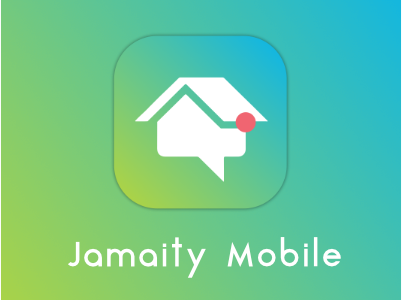
Appel d’offres منشور على "جمعيتي" في 11 août 2023
إكتشف المزيد من الفرص على "جمعيتي" عبر النّقر على هذا الرّابط.
